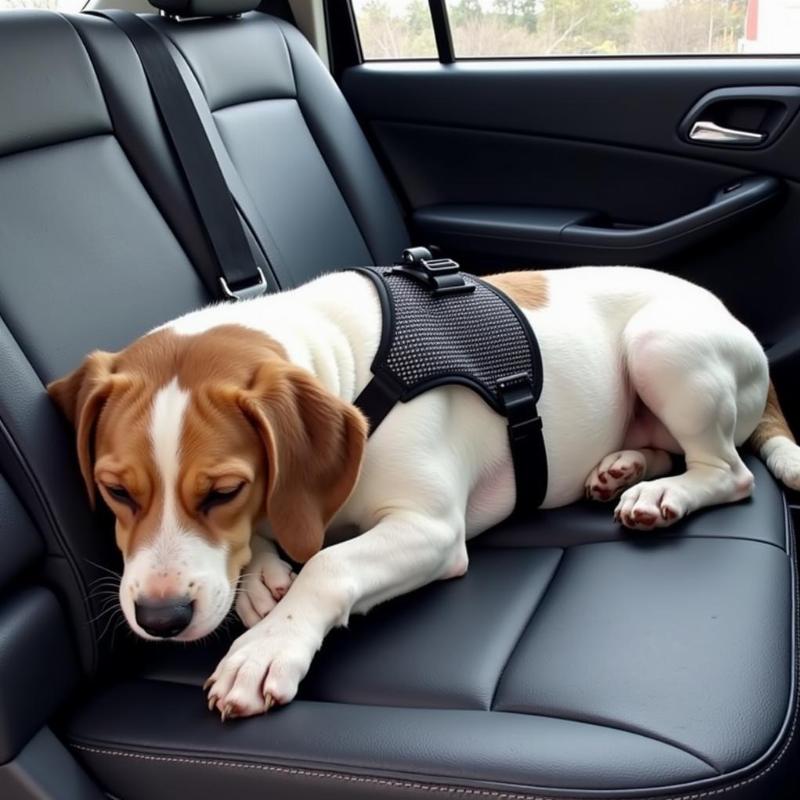Is it safe for your furry friend to snooze in their harness? Many dog owners wonder if their dog can sleep with a harness on. While it might seem harmless, sleeping in a harness can actually cause discomfort and even potential health issues for your pup. Let’s explore the reasons why it’s generally not recommended and what comfortable alternatives you can consider.
The Downsides of Harness Sleeping
While harnesses are great for walks and training, they aren’t designed for extended wear, especially during sleep. Here’s why:
- Chafing and Skin Irritation: Harnesses, even well-fitted ones, can rub against your dog’s skin, particularly in areas like the armpits and neck. This friction can lead to chafing, irritation, and even hot spots, especially for dogs with sensitive skin or thick fur.
- Restricted Movement and Discomfort: Sleeping in a harness can restrict your dog’s natural movements during sleep, making it difficult for them to get comfortable and potentially disrupting their sleep cycle. They may struggle to stretch, roll over, or find a comfortable sleeping position.
- Potential for Entanglement: If your dog’s harness has any loose straps or buckles, there’s a risk of entanglement with furniture or bedding, which could cause injury or distress.
- Pressure Sores: Continuous pressure from the harness, especially in certain pressure points, can lead to the development of sores over time. This is especially true for older dogs or those with mobility issues.
Safer and More Comfortable Alternatives
So, what are the best options for your dog’s sleep time? Here are a few alternatives to consider:
- A Cozy Dog Bed: Investing in a comfortable dog bed provides your furry friend with a designated space to relax and sleep soundly. Choose a bed that’s the right size for your dog and offers good support.
- Soft Blankets: A soft blanket can provide warmth and comfort for your dog during sleep, especially during colder months.
- Crate Training: If your dog is crate trained, the crate can become their safe haven for sleep. Make sure the crate is appropriately sized and well-ventilated.
Is There Ever a Time When a Dog Can Sleep in a Harness?
In certain limited situations, allowing a dog to sleep in a harness might be acceptable, such as during travel in a car or on a plane. In these cases, a well-fitted, non-restrictive harness can provide safety and security. However, even during travel, it’s ideal to remove the harness whenever possible to allow your dog to stretch and move freely.
 Dog sleeping in a car wearing a harness
Dog sleeping in a car wearing a harness
Tips for Choosing and Using a Harness
Even if your dog isn’t sleeping in their harness, proper fit and usage are crucial. Here are some tips from the American Kennel Club (AKC):
- Proper Fit: The harness should fit snugly but not too tight. You should be able to fit two fingers comfortably between the harness and your dog’s body.
- Regular Checks: Inspect the harness regularly for any signs of wear and tear, such as frayed straps or broken buckles. Replace the harness if necessary.
- Supervised Use: Always supervise your dog when they’re wearing a harness, especially during walks or training.
Conclusion
While it might be tempting to let your dog sleep in their harness for convenience, it’s generally best to avoid it. Prioritizing your dog’s comfort and well-being means providing them with a safe and comfortable sleeping environment free from restrictions. A cozy bed, soft blanket, or a crate are all excellent alternatives to ensure a good night’s sleep for your furry companion. Remember, a well-rested dog is a happy dog!
FAQ
- Can my puppy sleep in a harness? No, puppies are especially vulnerable to skin irritation and discomfort from harnesses. It’s crucial to remove their harness during sleep.
- What type of harness is best for my dog? The best type of harness depends on your dog’s breed, size, and activity level. Consult with a veterinarian or a professional dog trainer for recommendations.
- How do I clean my dog’s harness? Most harnesses can be hand-washed or machine-washed. Follow the manufacturer’s instructions for cleaning.
- My dog seems anxious without their harness. What should I do? Try introducing a comfort item, like a blanket or a toy, to help your dog feel more secure without their harness.
- Can a harness cause hip dysplasia? While a poorly fitted harness can exacerbate existing hip problems, it doesn’t directly cause hip dysplasia.
- What if my dog chews on their harness? If your dog chews on their harness, try distracting them with a chew toy or consider a chew-proof harness.
- My dog pulls a lot on walks. Will a harness help? Yes, a front-clip harness can help discourage pulling and make walks more enjoyable for both you and your dog.
Related Articles
About Beautdogs.us
Beautdogs.us is your premier online destination for all things dog-related in the USA. We offer expert advice on dog breeds, care, training, and product recommendations, catering to both seasoned dog owners and those just starting their journey with a furry companion. Our team of experienced veterinarians and dog experts provides reliable and up-to-date information, helping you navigate the joys and challenges of dog ownership. We aim to empower you with the knowledge and resources you need to provide the best possible care for your beloved canine friend. For inquiries, reach out to us at [email protected] or call us at +1 501-555-7529.